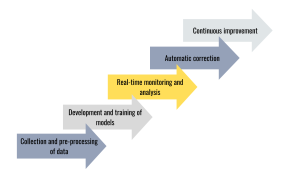Implementing AI in Software Maintenance
Introduction Software maintenance is an important aspect of the software development life cycle, often requiring a significant portion of resources and time. Traditional maint...

Introduction
Software maintenance is an important aspect of the software development life cycle, often requiring a significant portion of resources and time. Traditional maintenance methods largely involve reactive approaches in which problems are solved as they arise. However, with the advancement of artificial intelligence (AI) technologies, there has been a paradigm shift towards proactive maintenance strategies. By leveraging the power of artificial intelligence, organisations can anticipate and solve problems before they occur, resulting in improved software reliability, productivity, and user satisfaction.
Understanding Artificial Intelligence in Software Maintenance
AI in software maintenance involves the use of various techniques such as machine learning, natural language processing (NLP), deep learning and predictive analytics to analyse, predict and prevent software problems. These technologies enable software systems to learn from historical data, identify patterns, and make smart decisions autonomously.
Benefits of Implementing AI in Software Maintenance

- Proactive problem solving. Artificial intelligence algorithms can analyse vast amounts of data to detect anomalies and patterns that indicate potential problems. By identifying these issues early, organisations can take preventive measures to reduce risks and ensure smooth software operation.
- Predictive maintenance: AI-powered predictive analytics can predict when software components are likely to fail or degrade. This allows organisations to plan maintenance activities in advance, reducing downtime and minimising disruption to business operations.
- Improved resource allocation. By prioritising maintenance tasks based on AI data, organisations can optimise resource allocation and maximise the efficiency of their maintenance efforts. This ensures that critical issues are quickly resolved, minimising the impact on productivity and customer satisfaction.
- Improved software quality. AI algorithms can analyse code quality metrics, identify areas for improvement, and provide actionable recommendations to developers. By continually monitoring and optimising code quality, organisations can create more reliable and maintainable software products.
- Save money. Predictive maintenance strategies supported by artificial intelligence can significantly reduce the total cost of ownership (TCO) of software systems. By preventing costly downtime, minimising the need for emergency troubleshooting, and optimising resource utilisation, organisations can realise significant cost savings over the long term.
Implementation of AI in Software Maintenance

- Collection and pre-processing of data. The first step in implementing AI in software maintenance is to collect relevant data from various sources, including logs, monitoring tools, issue tracking systems, and customer feedback. Before data can be used for analysis, it must be preprocessed to remove noise, handle missing values, and ensure consistency.
- Development and training of models. Artificial intelligence models, such as machine learning classifiers or predictive analytics algorithms, are developed using preprocessed data. These models are trained on historical data to learn patterns and relationships between different variables, allowing them to make accurate predictions and recommendations.
- Real-time monitoring and analysis. Once trained, AI models are deployed into production environments to monitor software systems in real time. They continuously analyse incoming data streams, detect anomalies, and issue alerts when potential problems are identified.
- Automatic correction. In addition to detecting problems, AI systems can also automate remediation tasks by implementing self-healing mechanisms or triggering predefined actions based on predefined rules. This allows organisations to solve problems quickly and efficiently, without human intervention.
- Continuous improvement. AI models require constant monitoring and refinement to adapt to changing conditions and evolving threats. Organisations should regularly evaluate the performance of their AI systems, retrain models with new data, and incorporate stakeholder feedback to ensure optimal performance.
Conclusion
The introduction of artificial intelligence into software support offers enormous potential to revolutionise the way organisations manage and maintain their software systems. By applying proactive AI-based strategies, organisations can identify and resolve issues before they impact users, improve software quality, and achieve significant cost savings. However, successful implementation requires careful planning, a robust infrastructure, and an ongoing commitment to continuous improvement. As AI technologies continue to evolve, the future of software maintenance promises to be more efficient, reliable and sustainable than ever before.